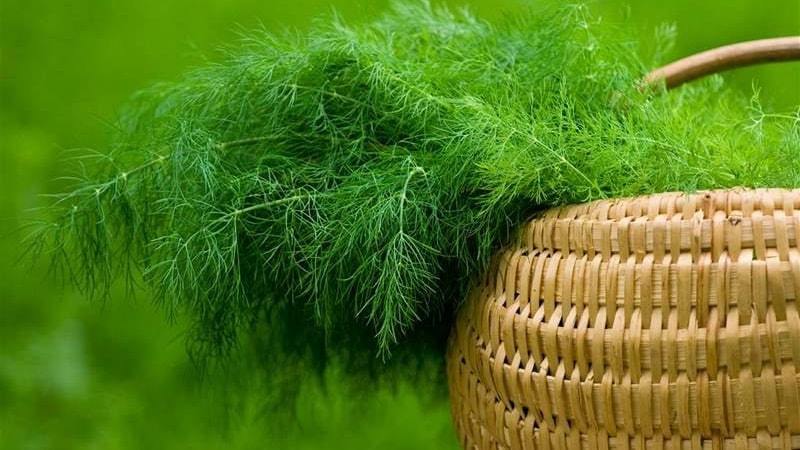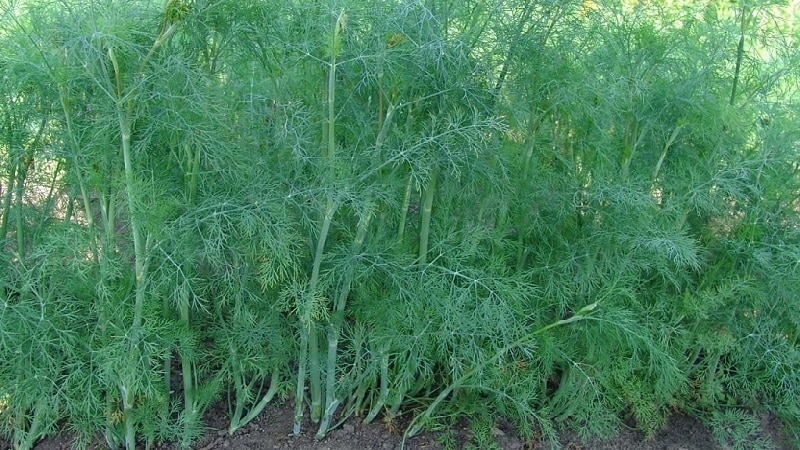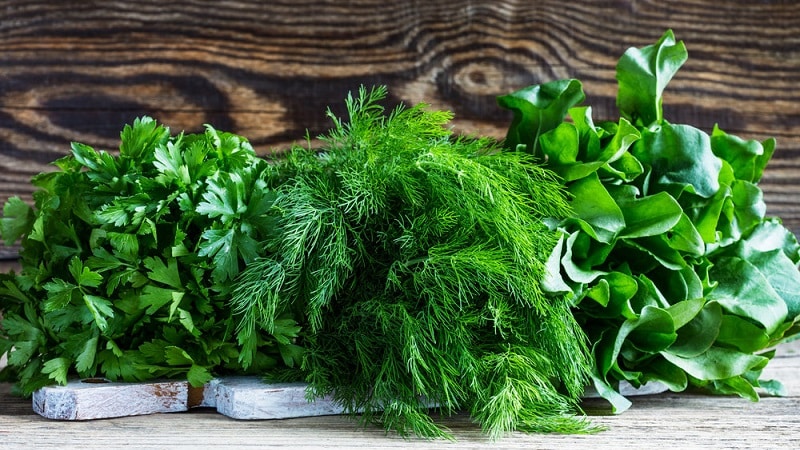Is dill a vegetable or not: characteristics and description of the plant
Dill is a common garden plant, unpretentious and easy to grow. It belongs to the category of green and spicy-flavoring crops; it is a valuable food and dietary product. The spice gives first and second courses a unique aroma and taste, enriches them with vitamins, and has healing properties.
The article will tell you about the beneficial qualities of dill, contraindications for use, options for use and features of agricultural technology.
Dill: vegetable or not?
First, let's figure out what category dill belongs to - is it a vegetable or a herb?
Dill is an annual spicy-flavoring plant of the Celery (Apiaceae) family.. This herbaceous crop belongs to the green category. This is the name for early ripening leafy vegetables, which, in addition to dill, include lettuce, spinach, mustard greens, Chinese cabbage, etc.

That's why For dill, both definitions are valid. This is a herbaceous crop, which from a culinary point of view can be called a vegetable.
Botanical description and characteristics of the plant
Garden dill has erect stems up to 150 cm high. At the beginning of growth, the stems are green and soft, then they begin to branch, and the main stem becomes woody. The leaves are bright green, strongly dissected, resemble a panicle, and have a persistent spicy aroma that stimulates the appetite.
The flowers of the plant are small, yellow, collected in inflorescences - complex umbrellas. In July–September, brown seeds form in place of flowers, the stem and leaves acquire a reddish tint.
Green leaves and side shoots are eaten. They are added to soups, main courses, and salads. Dill seeds are widely used as a spice for salting and pickling.
Reference! Vegetable greens are used for long-term storage. For this her dried, freeze And salt. At the same time, the aroma of the plant is preserved.
Chemical composition and properties
Dill leaves are distinguished by their high content of various vitamins and mineral salts. Low calorie content (only 40 kcal per 100 g) makes this vegetable an indispensable component of the diet menu.
The detailed chemical composition of the vegetable is given in the table:
| Nutritional value, g per 100 g | Vitamins, 100 g | ||
| Squirrels | 2,5 | Vitamin A | 750 mcg |
| Fats | 0,5 | Vitamin C | 100 mg |
| Carbohydrates | 6,3 | Vitamin E | 1.7 mg |
| Alimentary fiber | 2,8 | Beta carotene | 4.5 mg |
| Water | 85,5 | Vitamin PP | 1.5 mg |
| Starch | 0,1 | Vitamin B1 (thiamine) | 0.03 mg |
| Ash | 2,3 | Vitamin B2 (riboflavin) | 0.1 mg |
| Vitamin B5 (pantothenic acid) | 0.3 mg | ||
| Vitamin B6 (pyridoxine) | 0.2 mg | ||
| Macroelements, mg per 100 g | Vitamin B9 (folic acid) | 27 mcg | |
| Calcium | 223 mg | Microelements, per 100 g | |
| Magnesium | 70 mg | Iron | 1.6 mg |
| Sodium | 43 mg | Zinc | 0.91 mg |
| Potassium | 335 mcg | Copper | 146 mcg |
| Phosphorus | 93 mg | Manganese | 1.264 mg |
Dill is a real storehouse of vitamins, micro- and macroelements. The leaves of the plant contain magnesium and iron in an easily digestible form, which improve the process of hematopoiesis.

Dill is one of the record holders among vegetables for vitamin C content.. The concentration of ascorbic acid reaches 135 mg. This is much more than in citrus fruits, rowan berries, cauliflower and broccoli. The high content of vitamins gives dill antioxidant properties and allows it to be used for therapeutic and prophylactic purposes.
The essential oils it contains give the plant an appetizing spicy aroma.. There are 2-3 times more of them in seeds than in greens. Essential oil is used in the food, alcoholic beverage, medical industries, in the production of perfumes, cosmetics, soap, and toothpaste.
Attention! Adding dill seeds to pickles and marinades not only adds a piquant taste to preserves: the phytoncides contained in the plant prevent the development of mold.
What are the benefits of dill?
The therapeutic properties of dill have been known to people since ancient times. The ancient Egyptians used a decoction of spicy herbs to get rid of headaches, and the Romans used it for painful urination.
Dill also has other beneficial properties:
- improves the functioning of the gastrointestinal tract, enhances intestinal motility;
- increases the secretion of gastric juice, has a choleretic effect, stimulates appetite;
- due to the high content of ascorbic acid, it improves the condition of blood vessels and capillaries, slows down the aging process;
- normalizes the functioning of the cardiovascular system, lowers blood pressure;
- has disinfectant properties and is used to treat infections of the genitourinary system;
- eliminates colic and bloating in children;
- for bronchopulmonary diseases thins mucus and stimulates its discharge;
- useful for nursing women, as essential oils stimulate milk production;
- helps with constipation and flatulence;
- calms, reduces irritability, normalizes sleep;
- masks with the addition of greens, decoctions based on them relieve purulent rashes, whiten the skin, relieve redness and inflammation.

Possible harm
Sometimes it is better to limit the use of this spice. You should not consume dill in large quantities, as it has a vasodilating effect and lowers blood pressure. This can cause hypotension, deterioration of the condition, including fainting and temporary blurred vision.
Contraindications
It is undesirable to use dill:
- hypotensive patients;
- with poor blood clotting;
- pregnant women and during menstruation;
- in the presence of an allergic reaction.
Methods of application
Due to its taste and beneficial properties dill is widely used in cooking and folk medicine.
In cooking
In cooking, dill is used as a spicy-flavoring seasoning.. Fragrant green leaves and young shoots freshly used in the preparation of salads, sauces, and hot dishes. Greens are added to cottage cheese and cheeses.
The use of odorants has become widespread dill seeds when salting and pickling vegetables and mushrooms, sauerkraut.

In addition to home cooking, dill is used in the food and canning industries. Essential oils, obtained from seeds, are used to flavor baked goods, tea, drinks, marinades, vinegar, and various sauces.
In folk medicine
The healing properties of dill are widely used in folk medicine. Infusions, decoctions, and infusions are prepared from the leaves, stems and fruits of the plant. cosmetic masks.
Here are a few use cases:
- To prevent kidney and urinary tract diseases, an infusion of dill seeds is used. For this, 1 tbsp. l. crushed seeds pour 1 tbsp. boiling water and leave for ¼ hour. Then filter and take 1 tbsp. l. 3 times a day.
- For hypertension, heart and liver diseases, an infusion of dried dill leaves is used. 3 tbsp. l.herbs are poured into 0.3 liters of boiling water, simmered in a water bath for 15 minutes, then infused for 45 minutes. The finished infusion is added to a volume of 300 ml and taken ½ glass 3 times a day half an hour before meals.
- Dry dill seeds help cope with insomnia and stress. For this, 1 tsp. seeds are taken before meals with water. This same remedy has a diuretic effect.
- An infusion of dill seeds will improve lactation. 15 g of seeds are poured into 200 g of boiling water and left for 20 minutes. Then filter and take 1 tbsp. l. up to 6 times a day for 15 minutes. before meals.
- For severe coughs and bronchitis, an infusion of dill seeds will help. 1 tbsp. l. crush the seeds and pour 500 ml of boiling water, leave for 2 hours, filter and take 1 tbsp. l. 4 times a day.
- To freshen your breath and destroy pathogenic microflora in your mouth, it is recommended to chew dill leaves or seeds after meals.
- A lotion made from essential dill oil will help against acne on the face. To do this, add 2 drops of oil to 1 tbsp. water and wipe problem areas.
- Dill in combination with honey is a tasty and effective remedy for increasing male potency. Powdered dill seeds are mixed with honey in a 1:2 ratio. Take 1 tsp. no more than 2 times a day.
Basics of agricultural technology
Garden dill is an unpretentious plant, which is grown almost everywhere.

The agricultural technology for its cultivation is simple, but there are features that must be taken into account to get healthy, fragrant greens:
- To grow dill, select an area with light, loose soil rich in organic matter. The plant does not tolerate alkaline soils.
- For full growth and development, you need a sufficient amount of light, otherwise the leaves will lighten and the stem will stretch and droop.
- The best predecessors for dill are legumes, cabbage, and cucumbers. Areas where crops from the umbrella family (parsley, carrots, cumin, etc.) were grown are absolutely unsuitable.
- Organic matter is applied to predecessor crops; only mineral fertilizers are used for dill - per 1 m² 20 g of nitrogen and potassium and 30 g of phosphorus.
- Seeds are sown in open ground in mid-late April. Germination temperature is +4°C; covering material is used to speed up the process. The distance between the rows when sowing greens is 15-20 cm, the seeding depth is 2-2.5 cm. It is possible to grow dill using seedlings.
- To obtain early greenery, it is possible to sow dill before winter.
- Dill seeds take a long time to germinate: if you sow dry seeds, seedlings will appear only after 2-3 weeks. Therefore, before sowing, it is better to soak the seeds for 2-3 days in warm water, changing it several times a day.
- When fighting diseases (for example, powdery mildew), the use of pesticides is not recommended, since the leaves are eaten. Use “Fitosporin” or 5% tincture of iodine - 40-50 drops per 10 liters of water with an interval of 2-3 treatments every 5-7 days.
- In order to have young greens throughout the season, dill is sown at several times with an interval of 10-15 days, starting in mid-late April.
- Dill needs regular watering, loosening and weeding.
- Greens are edible 20-30 days after sowing with a stem height of about 15 cm.
- Dill reproduces well by self-sowing. To do this, simply leave a few plants with umbrellas, and in the fall, further loosen the soil so that the seeds germinate better.
In addition to growing on a personal plot, dill can be grown at home – on the windowsill.
Reference! When planted together with dill, the taste of peas, onions, beets, and white cabbage improves.

What do parsley and lettuce refer to?
In addition to dill, green crops and early leafy vegetables include parsley and lettuce.
Parsley also belongs to the celery family. It is used as a spicy vegetable to give dishes a special aroma and taste. All parts of the plant are eaten, including the root.
Lettuce is a vegetable crop from the Asteraceae family.. The succulent leaves or stems are eaten fresh.
Conclusion
Dill is a spicy green vegetable that enjoys well-deserved popularity all over the world. It is loved for its unique taste, appetizing aroma, valuable medicinal properties, ease of cultivation and unpretentiousness.